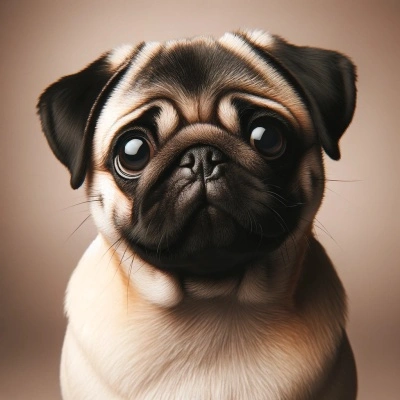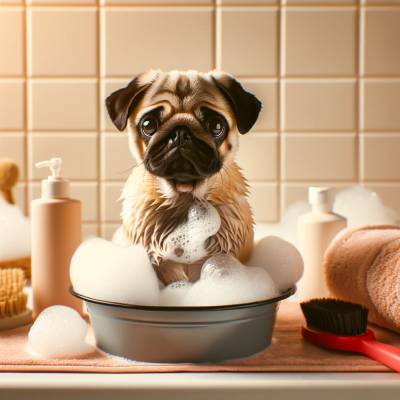Why Are Pugs So Cute? A Journey into Understanding Their Endearing Appeal

The unique charm of pugs captivates many, largely due to their distinctive features and endearing personalities. With their compact, muscular frames, expressive faces, and large, soulful eyes, these small canines exude an irresistible appeal. Their playful yet gentle temperament further enhances their attractiveness, making them beloved companions. Understanding the allure of pugs involves exploring both their physical characteristics and their amiable nature.
I. Introduction
A. Overview of Pug Popularity
The pug, a small but charismatic dog breed, has captured the hearts of many around the globe. Renowned for their unique appearance and delightful personalities, pugs have become a popular choice for pet owners. Their rise in popularity can be attributed to their adaptability to various living situations, making them ideal companions for both city and country dwellers. Their small size and minimal exercise requirements further contribute to their appeal, especially among those living in apartments or with limited space.
B. The Appeal of Pugs
Pugs are not just pets; they’re a phenomenon. Their appeal lies not only in their physical characteristics but also in their charming demeanor. These dogs are known for their affectionate and friendly nature, often seeking the attention and companionship of their owners. This strong bond between pugs and their human counterparts is a key aspect of their allure, making them more than just pets but beloved members of the family.
II. Physical Characteristics
A. Distinctive Facial Features
One of the most striking features of pugs is their expressive face. With large, round eyes and a flat, wrinkled muzzle, pugs have a distinct appearance that many find irresistible. Their facial expressions can range from curious and alert to relaxed and content, providing a window into their emotions and thoughts.
B. Body Structure and Size
Pugs are small, compact dogs with a sturdy build. They typically weigh between 14 to 18 pounds, making them a comfortable size for most homes. Despite their small stature, pugs are muscular and robust, with a square body shape and strong legs. This combination of strength and compactness adds to their charm, as they are both adorable and resilient.
C. Coat Colors and Textures
Pugs have a short, smooth coat that comes in a variety of colors, including fawn, black, and apricot. Their coat is fine and glossy, requiring regular grooming to maintain its shine and health. The contrast between their coat color and their distinctive facial features, like their dark, velvety ears and the mask on their face, further accentuates their appeal.
III. Behavioral Traits
A. Playful and Affectionate Nature
Pugs are known for their playful and affectionate demeanor. They enjoy being part of family activities and are often eager to play and interact with their owners. This breed is particularly known for its love of cuddling, often seeking out the laps of their human companions for comfort and warmth.
B. Adaptability to Various Environments
Pugs are remarkably adaptable and able to thrive in a variety of living conditions. They are just as comfortable in a bustling city apartment as they are in a spacious suburban home. This adaptability extends to their social behavior; pugs generally get along well with other pets and are friendly toward strangers, making them excellent family pets.
C. Intelligence and Trainability
Despite their sometimes stubborn nature, pugs are intelligent dogs. They can be trained effectively with patience and positive reinforcement. Their eagerness to please their owners and their love for treats make training sessions both productive and enjoyable. Pugs excel in learning basic commands and can even perform in dog sports like agility and obedience trials.
IV. Historical Background
A. Origins of the Pug Breed
The history of the pug is as fascinating as the breed itself. Originating in China over two thousand years ago, pugs were bred to be companions to Chinese emperors and their families. These dogs were so valued that they were often guarded by soldiers and treated with great respect.
B. Pugs in Cultural and Historical Contexts
Throughout history, pugs have held a special place in various cultures. In the 16th century, they were brought to Europe, where they quickly became favorites among royalty, including the House of Orange and the English monarchy. Pugs have been depicted in art and literature throughout the ages, further cementing their status as a breed of both historical and cultural significance.
V. Health Considerations
A. Common Health Issues in Pugs
Like all breeds, pugs have their share of health concerns. Due to their brachycephalic (flat-faced) nature, they are prone to breathing difficulties, especially in hot or humid weather. Eye problems are also common due to their prominent eyes. It’s important for pug owners to be aware of these issues and to seek veterinary care when necessary.
B. Care and Maintenance for Optimal Health
Proper care and maintenance are essential for a pug’s health and well-being. This includes regular veterinary check-ups, a balanced diet, and adequate exercise. Due to their tendency to gain weight, monitoring their diet and ensuring they get enough physical activity is crucial. Regular grooming is also important, as it helps prevent skin issues and keeps their coat healthy and clean.
The pug’s enduring appeal can be attributed to a combination of their unique physical traits, delightful personality, and rich history. As both a companion and a symbol of cultural significance, the pug continues to be a beloved breed.
VI. FAQs
Q: Why are pugs considered a good family pet?
A: Pugs are known for their affectionate and sociable nature, making them excellent companions for families. They are gentle and patient, often getting along well with children and other pets.
Q: Can pugs adapt to living in small apartments?
A: Yes, pugs are highly adaptable and can thrive in small living spaces such as apartments. Their moderate exercise needs and compact size make them well-suited for urban living.
Q: How often do pugs need to be groomed?
A: Pugs require regular grooming, including brushing their coat at least once a week to remove loose hair and prevent shedding. They also need routine cleaning of their facial wrinkles to prevent skin infections.
Q: Are pugs easy to train?
A: Pugs can be easy to train with the right approach. They respond well to positive reinforcement and consistent training sessions, although they can sometimes be stubborn.
Q: What are the common health issues in pugs?
A: Common health issues in pugs include respiratory problems due to their brachycephalic nature, eye conditions, and skin infections in their wrinkles. Obesity can also be a concern, so a proper diet and exercise are important.
Q: How long do pugs typically live?
A: Pugs typically have a lifespan of 12 to 15 years, although this can vary depending on their overall health and care.
Q: Why do pugs tilt their head?
A: Pugs often tilt their heads when they are curious or trying to understand something, such as a new sound or command from their owners. This adorable behavior may also help them to better capture sounds, given their flattened facial structure.
Q: Do pugs get along with other animals?
A: Generally, pugs get along well with other animals, including other dogs and cats. They are social and enjoy companionship, but introductions should be done carefully and gradually.
VII. Conclusion
A. The Enduring Charm of Pugs
The charm of pugs endures due to their unique combination of physical traits, lovable personalities, and rich historical background. These small canines continue to captivate hearts with their expressive faces and affectionate natures. As companions, they offer unwavering loyalty and endless entertainment, solidifying their place in the hearts of their owners.
B. The Role of Pugs in Modern Society
In modern society, pugs have transcended their role as mere pets, becoming symbols of love, companionship, and even fashion. They appear in media, influence pet trends, and participate in various dog-related activities and events. Their adaptability and affable nature make them well-suited to the diverse lifestyles of today’s pet owners, ensuring their popularity for years to come.
VIII. Suggested Readings
Before delving into the world of pugs, it’s beneficial to have resources that offer in-depth knowledge and insights. Here are five recommended books for anyone interested in learning more about this delightful breed:
- “Pugs: Everything About Purchase, Care, Nutrition, Breeding, Behavior, and Training” by Phil Maggitti: This comprehensive guide covers all aspects of pug care and is an invaluable resource for current or prospective pug owners.
- “The Pug Handbook” by Brenda Belmonte: A detailed book offering practical advice on keeping pugs healthy and happy from puppyhood to their senior years.
- “Pug Mugs: Good Pugs Gone Bad” by Willow Creek Press: A lighthearted and humorous look at the naughty side of pugs, filled with charming photos and witty captions.
- “The Complete Guide to Pugs” by David Anderson: An extensive guide that delves into the breed’s history, characteristics, and care requirements, ideal for both new and experienced pug owners.
- “Pug’s Guide to Etiquette” by Gemma Correll: A fun and whimsical book that humorously explores the world from a pug’s perspective, offering laughs and insights into their quirky behavior.
These books provide a wealth of information and enjoyment for anyone captivated by the allure of pugs. Whether you’re a seasoned pug owner or considering bringing one into your life, these readings offer valuable insights into the care, history, and unique traits of this beloved breed.






